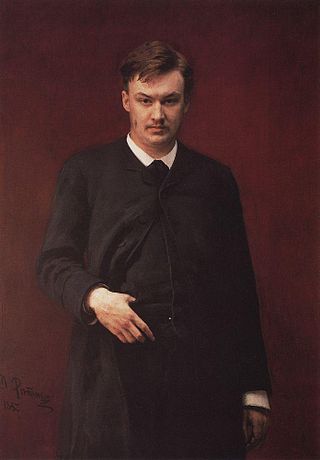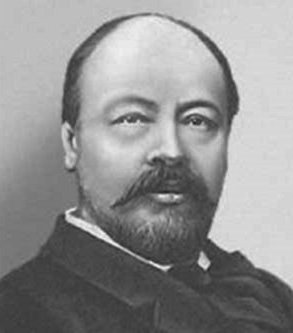Sources
- Soja Gulinskaja: Nikolai Jakowlewitsch Mjaskowski. Moscow 1981, German version Berlin 1985
The Symphony No. 1 in C minor, Op. 3, by Nikolai Myaskovsky was written in 1908 (and revised 1921).
It is in three movements:
The first sketches for this symphony were written at the time of Myaskovsky's studies in Saint Petersburg in February 1908. The following summer he wrote the piano score, and on the first, ninth and twenty-seventh of July, the movements were finished in piano reduction. In September he finished the orchestration. In this early period of his composition, Myaskovsky noticed his talent and enthusiasm for the symphony as a genre, but he didn't have the heart to show his work to his teacher for composition, Anatoly Lyadov. So he showed it, along with his friend and fellow student Sergei Prokofiev, to Alexander Glazunov, who granted him a scholarship immediately. In 1921 Myaskovsky revised the symphony and published this revised version in 1929. In 1931 a version for piano four-hands was published.
The music and the character of the early symphonies of Myaskovsky look back to the Russian Romantics like Tchaikovsky, Glazunov or Taneyev. Myaskovsky also tried to be open to modern influences, but his music wasn't modern enough for the contemporary Russian composers since his focus was on melody and voice-leading as he had learned from Nikolai Rimsky-Korsakov. The first symphony has many attributes which are characteristic for Myaskovsky's symphonies: The expansive exposition and variation of the themes, the use of polyphony and counterpoint and of course the preference for minor scales and sonata form. The outer movements are in C minor, the second is in A-flat major.
When Myaskovsky showed the sketches of the first symphony to Prokofiev, Prokofiev was appalled at some parts. In the last movement Myaskovsky had entwined four themes at one point and Prokofiev asked him why he did so: "For Lyadov's counterpoint-hours?". In the revised publication these bars are missing, the composer shortened the first and third movements and changed the instrumentation. The completion of the symphony had a bad effect on Myaskovsky: in the immediately following time he was very depressive, and it took a few months before he composed another symphonic work, the symphonic poem "Silence" (after Edgar Allan Poe). Boris Asafyev said about this symphony, that it reminded him of Mussorgsky's song cycle Sunless. The first performance on June 2 (o.s., May 20), 1914, in Pavlovsk was conducted by A. P. Aslanov; the conductor was thrilled by the music and asked for the score of the third symphony later. The Polish conductor Grzegorz Fitelberg asked for the score in 1914 and Myaskovsky was very happy to receive this request, since he was fighting on the front in the First World War at that time.

Nikolai Andreyevich Rimsky-Korsakov was a Russian composer, a member of the group of composers known as The Five. He was a master of orchestration. His best-known orchestral compositions—Capriccio Espagnol, the Russian Easter Festival Overture, and the symphonic suite Scheherazade—are staples of the classical music repertoire, along with suites and excerpts from some of his 15 operas. Scheherazade is an example of his frequent use of fairy-tale and folk subjects.

Alexander Konstantinovich Glazunov was a Russian composer, music teacher, and conductor of the late Russian Romantic period. He was director of the Saint Petersburg Conservatory between 1905 and 1928 and was instrumental in the reorganization of the institute into the Petrograd Conservatory, then the Leningrad Conservatory, following the Bolshevik Revolution. He continued as head of the Conservatory until 1930, though he had left the Soviet Union in 1928 and did not return. The best-known student under his tenure during the early Soviet years was Dmitri Shostakovich.

The Symphony No. 1 in F minor, Op. 10, by Dmitri Shostakovich was written in 1924–1925, and first performed in Leningrad by the Leningrad Philharmonic under Nicolai Malko on 12 May 1926. Shostakovich wrote the work as his graduation piece at the Petrograd Conservatory, completing it at the age of 19.

Reinhold Moritzevich Glière, was a Russian Imperial and Soviet composer of German and Polish descent. In 1938, he was awarded the title of People's Artist of RSFSR (1935), and People's Artist of USSR (1938).

Sergei Prokofiev wrote his Symphony No. 2 in D minor, Op. 40, in Paris in 1924-25, during what he called "nine months of frenzied toil". He characterized this symphony as a work of "iron and steel".

The N. A. Rimsky-Korsakov Saint Petersburg State Conservatory is a school of music in Saint Petersburg, Russia. In 2004, the conservatory had around 275 faculty members and 1,400 students.

Frederick Stock was a German conductor and composer, most famous for his 37-year tenure as music director of the Chicago Symphony Orchestra.

Anatoly Konstantinovich Lyadov was a Russian composer, teacher, and conductor.
Sergei Prokofiev's Symphony-Concerto in E minor, Op. 125 is a large-scale work for cello and orchestra.

Nikolai Yakovlevich Myaskovsky or Miaskovsky or Miaskowsky, was a Russian and Soviet composer. He is sometimes referred to as the "Father of the Soviet Symphony". Myaskovsky was awarded the Stalin Prize five times.
An unfinished symphony is a fragment of a symphony, by a particular composer, that musicians and academics consider incomplete or unfinished for various reasons. The archetypal unfinished symphony is Franz Schubert's Symphony No. 8, written in 1822, six years before his death. It features two fully orchestrated movements. While it seems clear from sketches that Schubert set out to create a traditional four-movement symphony, this has been the subject of endless debate. Schubert wrote the symphony for the Graz Musical Society, and gave the manuscript to his friend Anselm Hüttenbrenner, in his capacity as its representative. However, Hüttenbrenner did not show the score to the society at that time, nor did he reveal the existence of the manuscript after Schubert died in 1828, but kept it a secret for another 37 years. In 1865, when he was 76, Hüttenbrenner finally showed it to the conductor Johann von Herbeck, who conducted the extant two movements on 17 December 1865 in Vienna, adding the last movement of Schubert's third symphony as the finale. Music historians and scholars then toiled to "prove" the composition was complete in its two-movement form, and indeed, in that form it became one of the most popular pieces in the late 19th century classical music repertoire, and remains one of Schubert's most popular compositions.

Russian composer Sergei Rachmaninoff's Symphony No. 1 in D minor, his Op. 13, was composed between January and October 1895 at his Ivanovka estate near Tambov, Russia. Despite its poor initial reception, the symphony is now seen as a dynamic representation of the Russian symphonic tradition, with British composer Robert Simpson calling it "a powerful work in its own right, stemming from Borodin and Tchaikovsky, but convinced, individual, finely constructed, and achieving a genuinely tragic and heroic expression that stands far above the pathos of his later music."

Maximilian Osseyevich Steinberg was a Russian composer of classical music.
Alexander Scriabin's Symphony No. 1, Op. 26, in E major was written in 1899 and 1900. It is an ambitious first symphony, consisting of six movements, the last of which has a chorus and two vocal soloists. This work is one of the first in which Scriabin's idea of art morally transforming a person is clearly expressed.

Antar is a composition for symphony orchestra in four movements by the Russian composer Nikolai Rimsky-Korsakov. He wrote the piece in 1868 but revised it in 1875 and 1891. He initially called the work his Symphony No. 2. He later reconsidered and called it a symphonic suite. It was first performed in March 1869 at a concert of the Russian Musical Society.
Konstantin Saradzhev was an Armenian conductor and violinist. He was an advocate of new Russian music, and conducted a number of premieres of works by Pyotr Ilyich Tchaikovsky, Modest Mussorgsky, Igor Stravinsky, Sergei Prokofiev, Nikolai Myaskovsky, Dmitri Shostakovich, and Aram Khachaturian. His son Konstantin Konstantinovich Saradzhev was a noted bell ringer and musical theorist.
Nikolai Myaskovsky wrote his Symphony No. 9 in E minor, Op. 28, between 1926 and 1927. It was dedicated to Nikolai Malko.
The Russian composer Nikolai Myaskovsky wrote his Symphony No. 11 in B-flat minor in 1931/1932.
Nikolai Myaskovsky's Symphony No. 5 in D Major, Op. 18, was written in 1918. It was premiered on 18 August 1920 by the conductor Nikolai Malko.